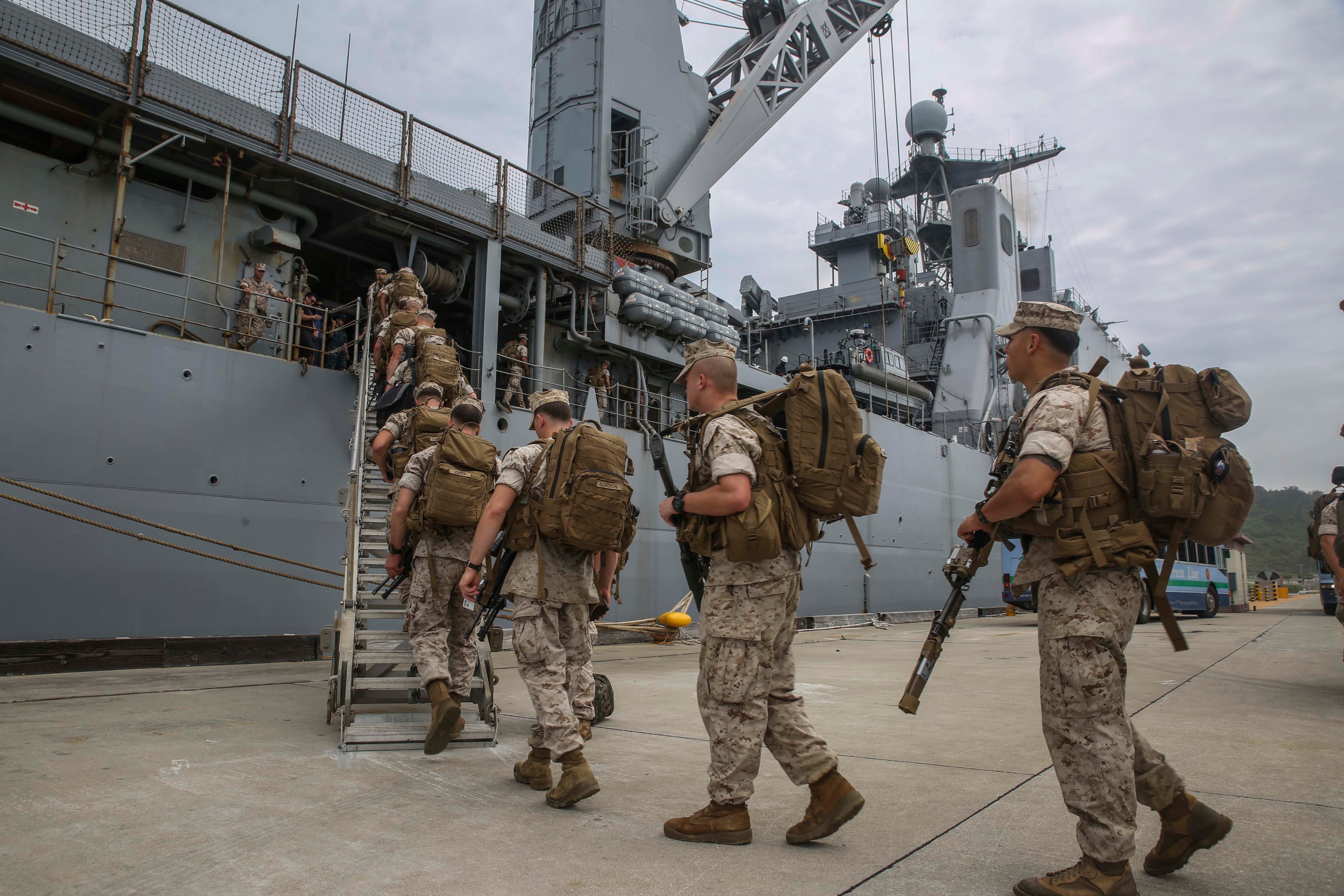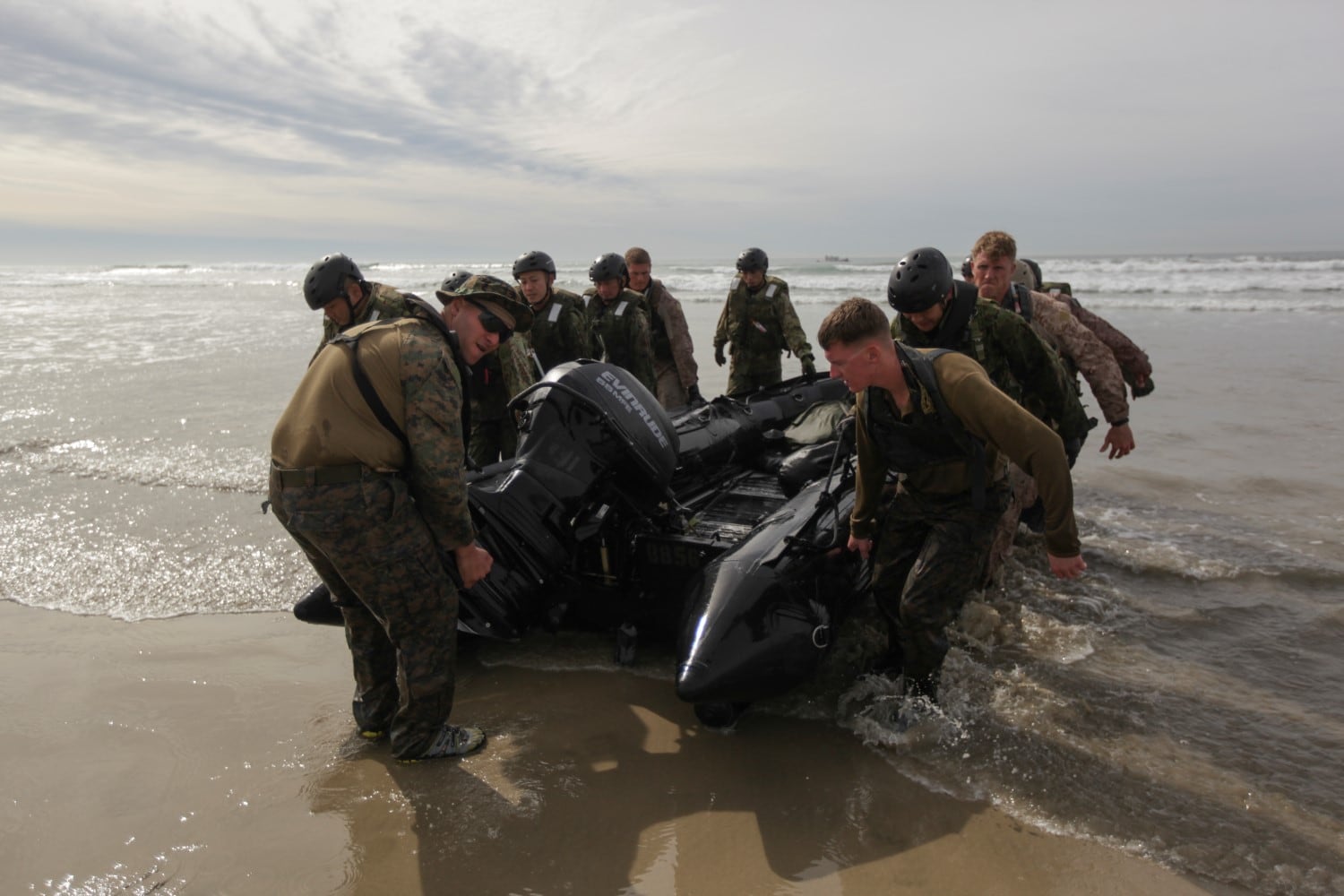Japanese troops Self-Defense Force soldiers are deploying with Marines as they head Down Under for a multinational amphibious training exercise Marines embarked upon the 31st Marine Expeditionary Unit, marking a first for both countries as tensions in the Asia-Pacific region continue to rise.
The move It represents the Japanese Self-Defense Force's latest step in boosting developing its amphibious operations capabilities. Thirty-one members of the Western Army Infantry Regiment are embedded with the 31st Marine Expeditionary Unit. The troops are deployed aboard the amphibious transport dock Green Bay, where they will head to Australia to participate in Exercise Talisman Sabre, a multinational exercise.
The major training session, scheduled to begin July 4, will include more than 33,000 U.S. and Australian forces this year, according U.S. Pacific Command officials said. Participants will simulate responses to military and humanitarian crises. In years past years, that has included a joint U.S.-Australian task force taking on a fictitious aggressive island nation.
Participating in Talisman Sabre will give the embedded Japanese troops an up-close look at how the Marines handle an international crisis, from logistics and communication to sending personnel ashore men and women ship-to-shore.
It's the first time the Japanese will participate involvement in the exercise, and follows another first, comes in the wake of a newly signed military agreement with the U.S. The framework gives Japan a larger role on the global stage, including allowing it to act in defense of allies.
Japanese troops joining the 31st MEU on its fall patrol deployment is one of the first developments to emerge following this new, robust military agreement. And it's a move China will watch closely, according to said foreign policy experts familiar with the region.
"They're very aware of everything Japan is doing and they're not particularly happy about it," said Michael Auslin, director of Japan Studies at the American Enterprise Institute, a Washington think tank. "They see it is aggressive and destabilizing. This is clearly jockeying for position on the part of both sides."
Building capabilities
The 31 Japanese troops deployed with the Okinawa, Japan-based MEU strong contingent embedded aboard the Green Bay brought along four combat rubber raiding crafts for use with Marines, said Capt. Jennifer Giles, spokeswoman for the 31st MEU. Exercise The Talisman Sabre exercise, which will showcase U.S., Japanese and Australian forces working together, is expected to serve as one of the highlights of the MEU's deployment.
"We train together to practice operating in a combined and joint environment, test interoperability and to refine procedures and doctrine," Giles said.
It's an arrangement that will benefit Tokyo as well as Washington, said Dakota Wood, a retired veteran Marine officer and senior research fellow at the Washington-based The Heritage Foundation. The Japanese will be learning how to conduct amphibious operations — something the nation has not done since World War II — from the best. Just learning how to go ship-to-shore would prove beneficial, he said.

U.S. Marines and sailors walk aboard the USS Ashland (LSD 48) in preparation for the annually- scheduled Fall Patrol of the Asia-Pacific region on May 7 at White Beach, Okinawa, Japan.
Photo Credit: Cpl. Ryan Mains/Marine Corps
"For the Japanese, it's the beginning of an exploration of how to think about and conduct military operations outside of their home waters," Wood said. "For Marine Corps side, it's just a continuation of working with the [Japanese Self-Defense Force]. You've got a longtime ally, the more things you could work on together the better."
That includes how different types of equipment work together, and command and control procedures, Wood said.
Japan's desire to regain the ability to conduct amphibious operations started in earnest just a few years ago. Officials there rededicated the Western Army Infantry Regiment for the purpose of rapidly responding to a crisis among the many islands that make up the Asian nation.
In the years since, Japanese soldiers worked increasingly close with the U.S. in bolstering their amphibious capabilities. In 2013, Japanese troops joined in on Exercise Dawn Blitz, a multinational training effort featuring amphibious landings and urban house-to-house combat, exercise held along the California coast.
A similar joint training session held earlier this year saw Japanese soldiers practice amphibious landings with 1st Reconnaissance Battalion, 1st Marine Division as part of Exercise Iron Fist, specifically held to foster Japan's capabilities and increase interoperability while strengthening relationships between the two nations. That exercise was also held in Southern California.
"This is the next logical step and it's something that both sides want to see," Auslin said of MEU deployment. "The Americans get a more capable ally that is more confident and experienced in working alongside American forces. The Japanese gain unparalleled access to the most advanced warfighting techniques … Both sides see it as a win-win."
But the joint deployment could is bound to irk Beijing and may raise eyebrows across a region with enduring memories of Japan's aggression during World War II.
A Pacific Cold War
Japan began its military's amphibious buildup in the wake of China's aggressive ship-building program and recent provocations in the Pacific.
Tensions between the two nations over the Senkakus Islands, eight uninhabited islands in the East China Sea between Japan and Taiwan, played a major role in growth of an amphibious force. The dispute — China, Japan and Taiwain all lay claim to the land — came to a head earlier this decade.
Since then, China Beijing has run patrols through the area and incorporated the islands under an air defense zone. Those actions spurred Japan Tokyo to create an air-ground force capable of defending the islands as well as other disputed — or potentially disputed — territories.

Marines with 1st Reconnaissance Battalion, 1st Marine Division, teach Basic Maneuver Techniques for the Combat Rubber Raiding Craft to members of the Japan Ground Self-Defense Force on Jan. 28 aboard Camp Pendleton, Calif., during Exercise Iron Fist 2015.
Photo Credit: Lance Cpl. Angel Serna/Marine Corps
"It's certainly about the increased Chinese assertiveness and the dispute over the Senkaku Islands," Auslin said. "Obviously, when they're concerned about protecting their islands — the possibility of having to retake Japanese territory — then the amphibious element is central."
Some in Japan Many in the Japanese left are suspicious of efforts to upgrade the nation's military. An attempt to alter its U.S.-written constitution to allow Japanese forces to act on behalf of allies has drawn strong criticism.
But sending the small team of Japanese soldiers out the amphibious force and joint deployment with the 31st MEU seems to have drawn less criticism, mostly because it's projected to be a defensive measure, said Sheila Smith, a senior fellow for Japan studies at the Council on Foreign Relations.
"There's always an ongoing conversation [there] about the appropriate roles of the uniformed forces of Japan," she said. "Clearly, if this was seen to be an exercise that looked offensive, that would be an occasion for some domestic concern outside the government. If it was seen as aggressive … that would clearly also be outside the parameters."
Ongoing concern in the region about a remilitarized Japan has largely been overshadowed by China's rise, Smith said. The Philippines and Vietnam have begun working closely with the island nation. Australia and Japan, given their position in the Pacific, make natural maritime partners, she said.
And there's Japan's most important regional relationship: Washington. As the U.S. pivots back toward the Asia-Pacific region militarily and diplomatically, tensions have flared with China.
The most recent example came in recent just the past few months: a diplomatic row over China's island-building project in the South China Sea. Beijing has since announced its controversial land reclamation effort is nearing an end, but not before an American pilot in aboard a P8-A Poseidon surveillance plane ignored repeated Chinese calls to leave international waters.
"I think that's given [the U.S. and Japanese] some urgency here that's current and that hasn't been in place before," Wood said.
Having another amphibious force in the region would be strategically significant, he said.
"You can't drive from Japan to cChina or from Korea to an island that's being contested, so the only way you can really shift capabilities or forces around is either by air or by ship and so somebody with an amphibious capability is going to have much more of a militarily significant capability," Wood said.




